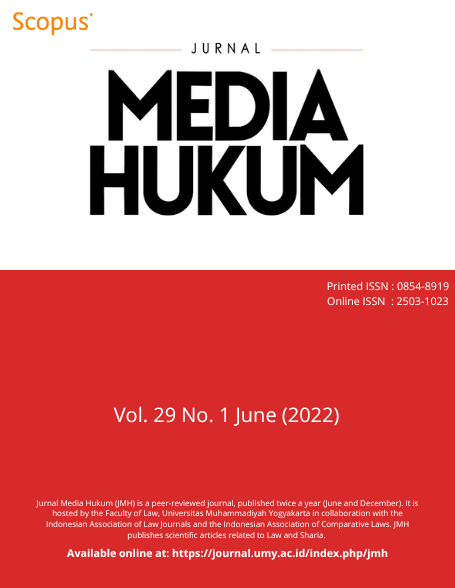Equity Interest Scheme in Polymetallic Nodules Deep Seabed Mining: The Positives and Negatives
DOI:
https://doi.org/10.18196/jmh.v29i1.13770Keywords:
Deep seabed mining, equity interest, UNCLOS 1982, reserved areaAbstract
UNCLOS 1982 initially obliged all applicants to submit a reserved area when applying for exploration activities in the Area. Such provisions were derogated when the equity interest scheme was introduced in the exploration regulations for polymetallic sulphides and cobalt-rich ferromanganese crust. The applicant may choose to submit a reserved area or offer an equity interest in a joint venture with the Enterprise. There has been a push to implement the same policy for polymetallic nodule (PMN) explorations. Although this prospect has sparked much support and rejections, there have been no scholarly articles substantiating such alignment's positive and negative impacts. Applying the scheme for all three types of minerals may significantly impact the implementation of the common heritage of mankind principle in the Area. This article normatively assesses the prospect of incorporating the equity interest scheme into the PMN utilization regime to identify its advantages and disadvantages compared to the reserved area scheme. The study found that incorporating the equity interest scheme for PMN would be oriented to optimize the financial benefits. However, it would further compromise the access for developing countries.References
Abramowski, T., Urbanek, M., & Baláž, P. (2021). Structural Economic Assessment of Polymetallic Nodules Mining Project with Updates to Present Market Conditions. Minerals, 11(3), 311. https://doi.org/10.3390/min11030311.
Arrow, D. W. (1982). The Customary Norm Process and the Rules of International Law: An Outline. Ocean Development and International Law, 9, 1–59.
Bernaz, N., & Pietropaoli, I. (2020). Developing a Business and Human Rights Treaty: Lessons from the Deep Seabed Mining Regime under the United Nations Convention on the Law of the Sea. Business and Human Rights Journal, 5(2), 1–21. https://doi.org/https://doi.org/10.1017/bhj.2020.7.
Dingwal, J. (2020). Commercial Mining Activities in the Deep Seabed Beyond National Jurisdiction: The International Legal Framework. In C. Banet (Ed.), The Law of the Seabed (pp. 139–162). Leiden: Brill Nijhoff.
Egede, E. (2009). African States and Participation in Deep Seabed Mining: Problems and Prospects. The International Journal of Marine and Coastal Law, 24(4), 683–712.
Final Act of the Third United Nations Conference on the Law of the Sea.
Focus-Economics. (2021). The World’s Top 5 Largest Economies in 2024. Accessed 5 December 2021, https://www.focus-economics.com/blog/the-largest-economies-in-the-world.
Guntrip, E. (2003). The Common Heritage of Mankind: An Adequate Regime for Managing the Deep Seabed? Melbourne Journal of International Law, 4, 376–405.
International Seabed Authority. (2001). Considerations Relating to the Regulations for Prospecting and Exploration for Hydrothermal Polymetallic Sulphides and Cobalt-Rich Ferromanganese Crusts in the Area, ISBA/7/C/2 29 May 2001.
International Seabed Authority. (2010). Decision of the Assembly of the International Seabed Authority relating to the regulations on prospecting and exploration for polymetallic sulphides in the Area, ISBA/16/A/12/Rev.1, 15 November 2010.
International Seabed Authority. (2011). Environmental Management Plan for the Clarion-Clipperton Zone, ISBA/17/LTC/7, 13 July 2011.
International Seabed Authority. (2012). Decision of the Assembly of the International Seabed Authority relating to the regulations on prospecting and exploration for Cobalt-Rich Ferromanganese Crusts in the Area, ISBA/18/A/11, 22 October 2012.
International Seabed Authority. (2012). The decision of the Council relating to an Environmental Management Plan for the Clarion-Clipperton Zone, ISBA/18/C/22, 26 July 2012.
International Seabed Authority. (2013). Decision of the Council of the ISA relating to Amendments to the Regulations on Prospecting and Exploration for Polymetallic Nodules in the Area and Related Matters, ISBA/19/C/17, 22 July 2013.
International Seabed Authority. (2018). Issue Related to the Possible Alignment of the Authority’s Regulations on Prospecting and Exploration Concerning the Offer of an Equity Interest in Joint Venture Arrangement, ISBA/24/LTC/4, 6 February 2018.
International Seabed Authority. (2018). Report of the Chair of the Legal and Technical Commission on the Work of the Commission at the First Part of its Twenty-Fourth Session, ISBA/24/C/9, 26 April 2018.
International Seabed Authority. (2019). Current Status of the Reserved Areas with the International Seabed Authority. Accessed 2 December 2021, https://www.isa.org.jm/files/files/documents/statusofreservedareas-01-2019-a.pdf.
International Seabed Authority. (2019). Environmental Management Plan. Accessed 3 December 2021, https://www.isa.org.jm/minerals/environmental-management-plan-clarion-clipperton-zone.
International Seabed Authority. (2019). The Mining Code: Draft Exploitation Regulations. Accessed 2 December 2021, https://isa.org.jm/mining-code/draft-exploitation-regulations.
International Seabed Authority. (2020). Exploration Contracts. Accessed 17 September 2021, https://www.isa.org.jm/exploration-contracts.
Jaeckel, A., Ardron, J. A., & Gjerde, K. M. (2016). Sharing Benefits of the Common Heritage of Mankind – Is the Deep Seabed Mining Regime Ready? Marine Policy, 70, 198–204.
Li, Y. (1994). Transfer of Technology for Deep Sea-bed Mining: The 1982 Law of the Sea Convention and Beyond, London: Martinus Nijhoff Publishers.
Moses, J. W., & Brigham, A. M. (2021). Whose benefit? A comparative perspective for the ISA. Marine Policy, 131, 1-7. https://doi.org/10.1016/j.marpol.2021.104550.
Nandan, S. N., & Lodge, M. W. (2002). The Development of the Regime for Deep Seabed Mining. Virginia: Center for Oceans Law and Policy.
Nandan, S. N., & Lodge, M. W. (2002). The Development of the Regime for Deep Seabed Mining. Center for Oceans Law and Policy.
Olney, W. W. (2013). A Race to the Bottom? Employment Protection and Foreign Direct Investment. Journal of International Economics, 91(2), 191–203.
Protocol on Environmental Protection to the Antarctic Treaty 1991.
Salvatore, D. (2004). Globalization, Comparative Advantage, and Europe’s Double Competitive Squeeze. Global Economy Journal, 4(1). https://doi.org/10.2202/1524-5861.1001.
Sharma, R. (2011). Deep-Sea Mining: Economic, Technical, Technological and Environmental Considerations for Sustainable Development. Marine Technology Society Journal, 45(5), 28–41. https://doi.org/https://doi.org/10.4031/MTSJ.45.5.2.
Snoussi, M., & Awosika, L. (1998). Marine Capacity Building in North and West Africa. Marine Policy, 22(3), 209–215.
Teague, J., & Scott, T. (2017). The use of low-cost ROV for deep-sea mineral ore prospecting. Applied Earth Science, 126(2), 100–101. https://doi.org/10.1080/03717453.2017.1306301.
Treaty on Principles Governing the Activities of States in the Exploration and Use of Outer Space, Including the Moon and Other Celestial Bodies 1967.
United Nations Convention on the Law of the Sea 1982.
US Department of State Bulletin. (1976). The Law of the Sea: A Test of International Cooperation.
Wang, Z. (1991). China and the Exploitation of Deep Seabed Polymetallic Nodules. Marine Policy, 15(2), 132–135. https://doi.org/https://doi.org/10.1016/0308-597X(91)90012-Z.
Willaert, K. (2021a). Deep sea mining and the United States: Unbound powerhouse or odd man out? Marine Policy, 124. https://doi.org/10.1016/j.marpol.2020.104339.
Willaert, K. (2021b). The Enterprise: State of affairs, challenges and way forward. Marine Policy, 131, 1–6. https://doi.org/10.1016/j.marpol.2021.104590.
World Bank. (2019). Gross Domestic Product 2019. Accessed 5 December 2021, https://databank.worldbank.org/data/download/GDP.pdf.
Yarn, D. (1984). The Transfer of Technology and UNCLOS III. Ga. J. Int’l & Comp. L., 14(1), 121–153.










